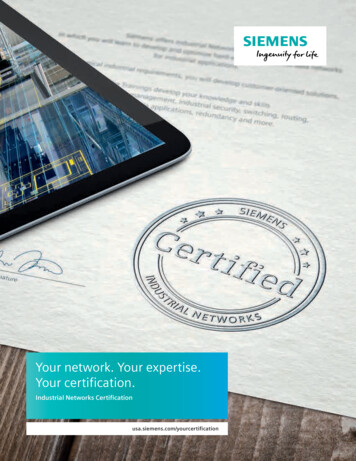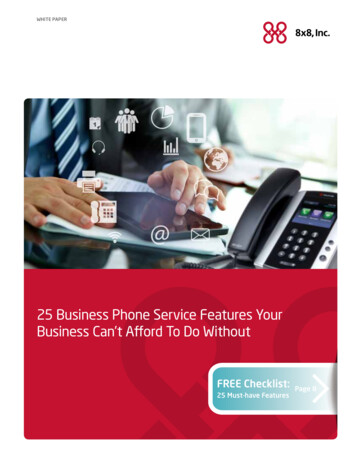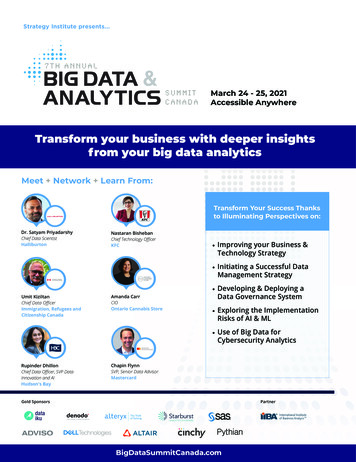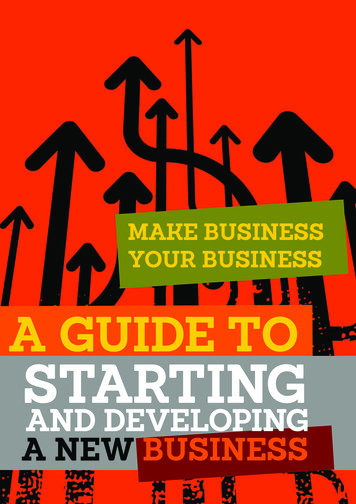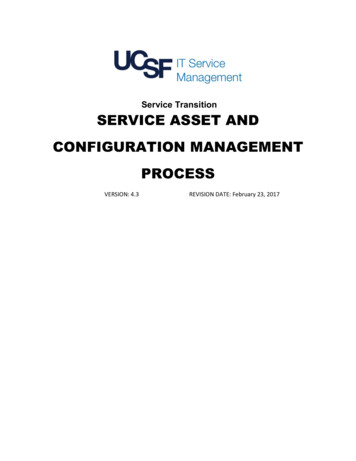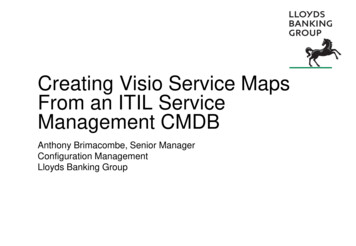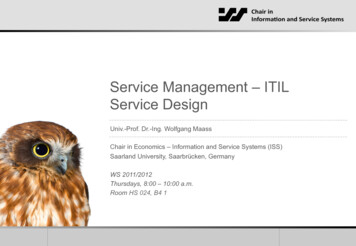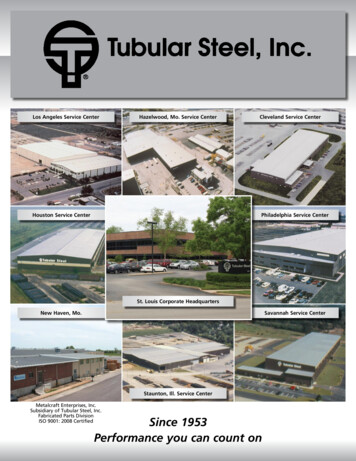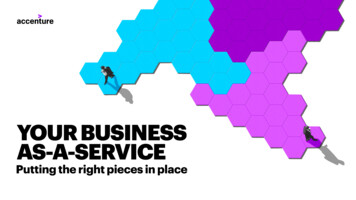
Transcription
YOUR BUSINESSAS-A-SERVICEPutting the right pieces in place
Increasingly, customers are expectingdigital experiences from the products andservices they buy; and this developmentis putting increasing pressure onall types of companies to developAs-a-Service capabilities thatcan meet these expectations.While an As-a-Service business model has significant benefits, capturing its full value isnot easy. It requires a multi-year journey, with many challenges along the way includingevolving financial models, supply chain management, and new sales and supportmodels. Progress toward the new model must be carefully managed in order to avoidundesired impacts on near-term operations. In pursuing this balancing act, companiesoften make avoidable, costly mistakes that can impact growth and reduce profitability.2 YOUR BUSINESS AS-A-SERVICE
Learning from the companies who have made the pivotThe As-a-Service experience can certainly be verydifferent for companies who are starting with a cleansheet, compared with those who are augmentingor transitioning an existing business. It can be furthercomplicated based on the type of product and specificuser needs, such as hardware, medical device, telecom,or industrial firms. However, a number of broadlyapplicable lessons can be learned from the experiencesof companies who have successfully made the pivotto a subscription-oriented business model. One of themost fundamental lessons is this: it is critical to considerthe applicability of this model to your business, soonerrather than later.As Figure 1 shows, many leading companies are alreadyon the journey to successfully using this model.3 YOUR BUSINESS AS-A-SERVICEFigure 1: As-a-Service movers come in many varietiesCompanyDatesDescriptionTypeAdobe12012 - PresentFull transition to SaaS modelSoftware Marketing ApplicationsInuit22008 - PresentSuccessful 10-year full transitionjourney to SaaSSoftware Financial and Payroll ProductsServiceNow12014 - PresentFull transformation to Enterprise SaaSSoftware IT and ServiceManagement ProductsCisco32012 - PresentComplimentary software and servicesthat attach to core networking hardwareCollaboration, Securing andNetworking ProductsLenovo42017 - PresentDevice-as-a-ServicePC and Hardware SolutionsSchneiderElectric12015 - PresentIndustrial Platform-as-a-ServiceElectrical and Building IOT SolutionsFaurecia12017 - PresentAuto Platform-as-a-ServiceAutomotive Solutions IOT SupplierSignify(Phillips Lighting)12016 - PresentLighting-as-a-ServiceLighting and Energy IOT Solutions
As Figure 2 demonstrates, waves of companies frommultiple industries have adopted As-a-Service models. Thefirst wave, which took place starting around 2008, featuredmany forward-thinking software providers. They werefollowed by hardware companies who added subscriptionservices to their portfolios. Most recently, industrialfirms have embraced Internet of Things (IoT) and otherconsumption models for their B2B products and services.“When it comes toinnovation, an ounce ofexecution is worth morethan a ton of theory.”PHIL MCKINNEYCEO of CableLabs, Author, and Syndicated Talk Show HostFigure 2: Waves of as-a-service transformation have washed over multiple industries6ONLY%OF COMPANIEShave managed to createfinancial impact fromtheir digital investmentsTHIRD WAVEIndustrial Companies(IOT/EaaS)SECOND WAVEHardware Companies(DaaS/NaaS)FIRST WAVESoftware Companies(SaaS)OF EXECUTIVESagree that failure to leverage ‘digitalvalue components’ of Industry X.0 willcause them to struggle for survival.(as quoted in CIO Magazine)TIMEBased on the experiences of companieswho have built successful As-a-Servicebusinesses, here are some of the mostimportant considerations to help acceleratetransition to these new models, whileavoiding unnecessary pitfalls along the way.4 YOUR BUSINESS AS-A-SERVICE64%Source: Accenture Industry X.0 survey of 931 senior executives across manufacturing and production industries
1Embrace the need for culturaland organizational changeEarly movers will confide that the hardest part of embracing an As-a-Service operating model is the cultural impact.There are significant cultural and organizational differences from more traditional operating models, including:THE NEED FOR C-SUITE SPONSORSHIPLEARN FROM MISTAKESUnlike many other types of new products or offerings, As-a-Service requires changesacross the business. Because of the sweeping nature of these changes, it is mandatorythat the executives who are running the business fully support this initiative. Seniorexecutives are the only group who can make such strategic decisions as how fast thecompany should move and how deeply it should invest. If there is only minimal orsuperficial commitment to support the initiative with appropriate resources, or to align itwith the company’s strategy, the As-a-Service initiative is likely to run into trouble.The approach to innovation is quite different than at a traditional hardwareor industrial company. Traditional businesses have little tolerance for failedinitiatives; they see them as wasted budget, with largely negative consequencesfor those involved. By contrast, As-a-Service firms experiment with multipleideas, test them, and then scale the winners. In this model, the idea of “failingfast” is not only acceptable, but necessary.AN EMPHASIS ON BUILDING DURABLE CUSTOMER RELATIONSHIPSIt is essential that customers have a superior user experience, because if they don’trenew their subscription, the As-a-Service business will fail. A customer-centric cultureis needed to help drive how products are developed, sold, supported and renewed.SENSITIVITY TO RATE AND PACEWhile most companies measure time in months and quarters, As-a-Servicebusinesses operate based on seconds and minutes. This includes how fastproducts are released, the measurement of metrics, the speed of the salesprocess, and time-to-value for the customer.5 YOUR BUSINESS AS-A-SERVICEINCREASED COLLABORATIONThis model requires a significantly higher degree of collaboration between groupsthan is seen in more traditional models. In fact, in the As-a-Service model, groupsare frequently consolidated in order to improve collaboration and business velocity.New functional groupings often include DevOps (Development Operations)and Customer Success (Services Training Support Account Management).Whatever form It takes, a high degree of collaboration is at the heart of movingquickly and delivering value to the customer.
2Deliver a superiorcustomer experience3Build in telemetry fora data-driven experienceThe As-a-Service model is centered around delivering a superior customer experiencethat makes offerings easy to implement, adopt, renew and expand. When it comes todesigning the customer experience, traditional businesses tend to use the waterfallapproach that is common in the technology industry, where a product Is built for whatIt can do, instead of what customers need It to do. By contrast, successful As-a-Servicecompanies are very skilled at building out an experience that meets the needs of the user.Successful As-a-Service companies deliver their offerings using cloud-basedplatforms, which can capture data that can inform product development, optimizeoperations, and better comprehend how to fine-tune the customer experience. Thisis only possible, however, if user telemetry capabilities are built into products andplatforms, so that DevOps and customer success teams can carefully monitor usage,performance and uptime.Companies that offer As-a-Service options without achieving differentiation around userexperience (UX) are making themselves vulnerable to disruption. A great UX will help toensure product stickiness. If customers find it is easy to use the product, they will morerapidly adopt and consume its functionality, creating a barrier against switching.This telemetry data can also be rolled up to calculate business metrics and KeyPerformance Indicators (KPIs) that inform leaders how to run their subscriptionbusiness. Instrumentation will build in the proper telemetry, as well as analyticalcapabilities that enable As-a-Service companies to offer proactive services gearedto fixing problems before they happen.Early movers in As-a-Service were quick to compress the post-sales processes andtheir respective teams—including professional services, training, and support—into asingle team focused exclusively on making their customers successful, often calledCustomer Success. The team’s primary objective was to be customers’ internaladvocate in order to ensure they received value from the product or service. Thiswas a big shift from the reactive way most companies had previously handled theircustomer relationships. Companies also found that it helped to hire employees whowere experienced in working in similar subscription-based environments that werealigned around customer success.6 YOUR BUSINESS AS-A-SERVICE
4Rethink your go-to-market& route-to-marketThe sales model for As-a-Service products is substantially different from a traditionalhardware or industrial product sales model, which is based on collecting a one-timeupfront payment. By contrast, As-a-Service sales activities are typically geared towardscapturing market share with higher velocity, using a Land and Expand approach.Employing a subscription model, this approach combines a lower upfront paymentwith ongoing fee collection.In this Land and Expand model, sales quotas and commissions must be aligned in order tomotivate sales teams to use more direct, rapid sale tactics. This often requires new typesof sellers with different technical skills. Existing sales teams need to be retrained to fitinto the new roles of hunter (new accounts) and farmer (existing accounts).As-a-Service sales activities are also more aligned to a direct sales model andless dependent on selling through partners. Instead of using distributors andresellers, the new channel approach for As-a-Service is more of an ecosystem playthat leverages Systems Integrators (like Accenture), Independent Software Vendors(ISVs) and Managed Services Providers (MSPs) who understand how to manage a longterm customer relationship. Like the direct sales team, channel partners who want toparticipate in this new model will also need transformational training to successfullyembrace new sales and post-sales (customer success) activities.7 YOUR BUSINESS AS-A-SERVICE5Establish a purpose-builtsubscription infrastructureThe success of an As-a-Service offering is dependent on the underlying business andtransactional infrastructure supporting the service. Organizations should understandthe public and private cloud products supporting Customer Relationship Management(CRM), Contract-Price-Quote (CPQ), billing and entitlements. These solutions may berequired for support of the core business, or may exist in parallel to it. Either way, thenew subscription infrastructure will enable new types of sales activities, monetizationstrategies (consumption) and a more frictionless experience for customers.Another advantage of this purpose-built subscription infrastructure is that it makes iteasier to integrate acquired SaaS or subscription software companies into the company’stransaction systems, which can eliminate a lot of unwanted manual processing.It is critical to incorporate security and compliance into the service delivery platform,as well as a robust disaster recovery capability, and to consistently manage to theService Level Agreement (SLA) that has been defined with the customer.
6Recognize that it’s allabout agile platformsOne of the biggest changes from a traditional operating model is the importance ofa product and services platform for the business. This platform is used to securelydeliver the As-a-Service offerings, monitor their usage, allow customers to self-serve,and provide a foundation for developers to build new solutions. When a platform isimplemented properly, it can enable an As-a-Service business to scale exponentiallywithout a proportionate increase in operating costs. In fact, it is largely thisopportunity for margin expansion that makes these companies so valuable.Individual developers are not the only ones attracted to these platforms. Partners whowant to build value-added solutions also prefer the use of platforms because they offera way for both parties to monetize these new solutions. Customers like to buy solutionsfrom companies that have broad ecosystems, like Salesforce, Amazon and Microsoft,because they offer access to a wide variety of products and services through theirplatform partners.Development of these platforms requires a deliberate agile product engineeringstrategy that is fundamentally different from the traditional waterfall approach, withits typical 12- to 18-month release cycles. As-a-Service products are developed usingan incremental approach with frequent updates, which requires an agile, fast-pacedset of software engineering practices. This approach typically includes the release ofMinimal Viable Products (MVPs) to test customer adoption in order to build value overtime, rather than relying on big-bang releases. As-a-Service product engineering groupsalso need the talents and skills required to take advantage of the latest technologiesand development techniques used to drive innovation.8 YOUR BUSINESS AS-A-SERVICE
7ThinkholisticallyFigure 3: The as-a-service model requires interconnected processesSTRATEGYHow will you monetizeyour software?As-a-Service requires changing not just the product,but also the operating model and the infrastructure.Executives seeking to build a new As-a-Service businessoften get stuck thinking inside of their existing functionalsilos. Instead of focusing on problems at the level of,say, a billing system issue, it’s important to recognizethat in a subscription-based business model, everythingis interconnected, and problems need to be addressedholistically. Figure 3 illustrates this operating model’sinterconnectedness acr
As-a-Service sales activities are also more aligned to a direct sales model and less dependent on selling through partners. Instead of using distributors and resellers, the new channel approach for As-a-Service is more of an ecosystem play that leverages Systems


